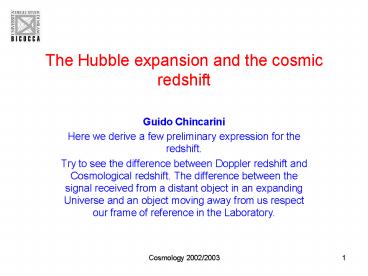The Hubble expansion and the cosmic redshift - PowerPoint PPT Presentation
Title:
The Hubble expansion and the cosmic redshift
Description:
The Hubble expansion and the cosmic ... The photon takes tp go from A to B a transit time t = l/c and the observer B is moving ... Document presentation format: – PowerPoint PPT presentation
Number of Views:53
Avg rating:3.0/5.0
Title: The Hubble expansion and the cosmic redshift
1
The Hubble expansion and the cosmic redshift
- Guido Chincarini
- Here we derive a few preliminary expression for
the redshift. - Try to see the difference between Doppler
redshift and Cosmological redshift. The
difference between the signal received from a
distant object in an expanding Universe and an
object moving away from us respect our frame of
reference in the Laboratory.
2
The events
- Time like
- ds2 gt 0. For instance I have two events at the
same location. In this case ds2 c2 dt2. - Space like
- ds2 lt 0. Two events occurr at the same time,
dt0, in different locations and we have ds2
-dl2. - Light like
- ds 0. Two points can be connected by a light
signal. - ds2 c2 dt2 - dl2.
3
Distance between two points
- I measure at the same time so that dt0.
- For convenience I use r rather than ? in the
Robertson Walker metric we just derived. I
indicate by d the distance.
B
tt1
A
World Lines
I choose a system of coordinates For which ??0 ,
?? 0.
4
Always A B
At the time t A B are separated by l(t) proper
distance and that is a function of the time t.
l is the proper separation L0 the separtion
(comoving)
This I could interpret as the Hubble law
?v
B
Now assume that both observers see the transit of
a photon. The photon takes tp go from A to B a
transit time ?t ?l/c and the observer B is
moving relative to the first observer with a
speed ?v.
A
5
Since ?l is small I use the Doppler. Furthermore
I define as ?a the Variation of a in the time ?t.
I can write
And what about if a particle transit the two
observers? A sees a particle passing by with a
certain velocity v and however B is moving
relative to A with a velocity that we call now ?u
(á/a) ?l. We also remind that the particle
moves rather fast. Lorentz Transformations
If the extremety of the wave are attached to the
sides of the box by making the box larger or
smaller I change the wavelength.
6
Lorentz Transformation - Coordinates
ux dx/dt uy dy/dt
S
S
v
S measure S moving with velocity v along the x
axis
7
Lorentz Transformation - Velocities
8
?u (á/a) ?l
B
A
9
Integrating
10
The concept of Pressure
- If for the galaxies I write ? ? c2 where ? is
the mass density I have - P ? ?T ? ? v2 c2/c2 ? ? v2/c2
- I could estimate at the time tt0 (now) the rms
velocity of the galaxies. This is in the range 50
to 1000 km/s going from the field to clusters of
galaxies. For larger Structures as
Super_clusters, not virialized however, we have a
dispersion in velocity (infall) of about 500
km/s. In this case - P 10-5 10-6 very small p0
- On the other hand we have seen ? v ? 1/a(t) which
may become very large for a(t) small. In the past
the motions of galaxies should have been very
turbolent and v rather high. In this case the
pressure term could be ? from zero. However - The galaxies form and evolve when a(t) is
smaller. That is before considering the above
relation between p ? I must understand the
physics at that epoch. - If I simply extrapolate the relation ? v ? 1/a(t)
at a point where v c my result breaks down. - In the relativistic domain I must use p 1/3 ? .
11
Pressuresee Vol I Relativistic Astrophysics by
Zeldovich and Novikov
- ? lt 50 g cm-3
- There are pronounced individual and chemical
properties of the elements which change from one
element to the next in accordance with
Mendeleevs periodic law. - 50 lt ? lt 500
- 500 lt ? lt 1011
- 1011 lt ? lt 1014
- 1014 lt ? lt 1016
- 1016 lt ? lt 1093
- ? gt 1093
- A student will work on this or I should be
reminded to prepare for it.
12
Cosmological redshift
?
? Tem
ds2 0 d? 0 d? 0
Photon
Tem
Tem ? tem
13
Transform the Integral
Tem
Tem?Tem
Tobs
Tobs?Tobs
D
A
C
B
DAB-C
14
And Finally
I assume that a(t) ? ?(t) so that a(t) does not
change (small and I can disregard it) during the
interval ?t. That is I can write































